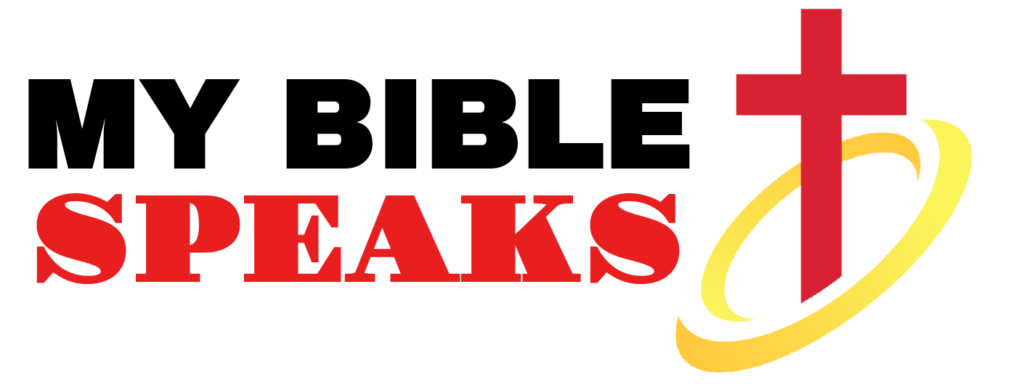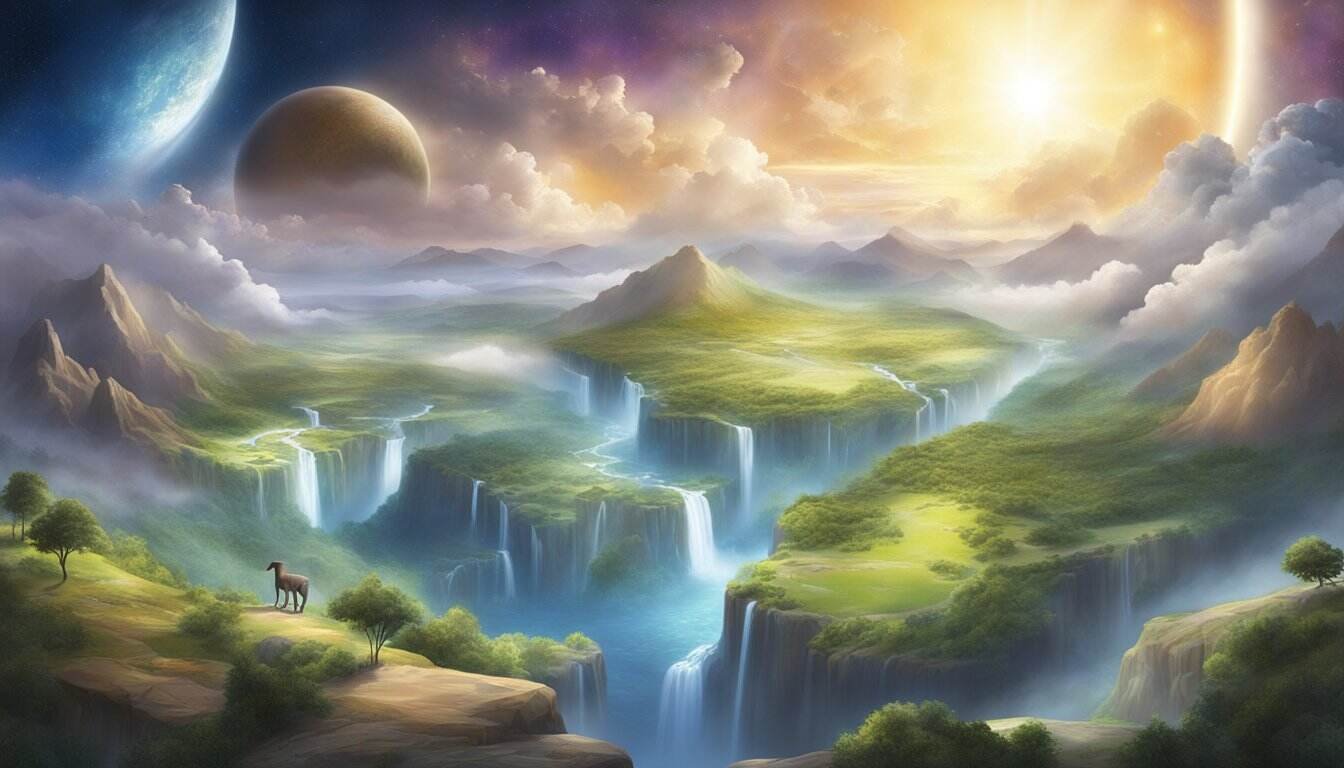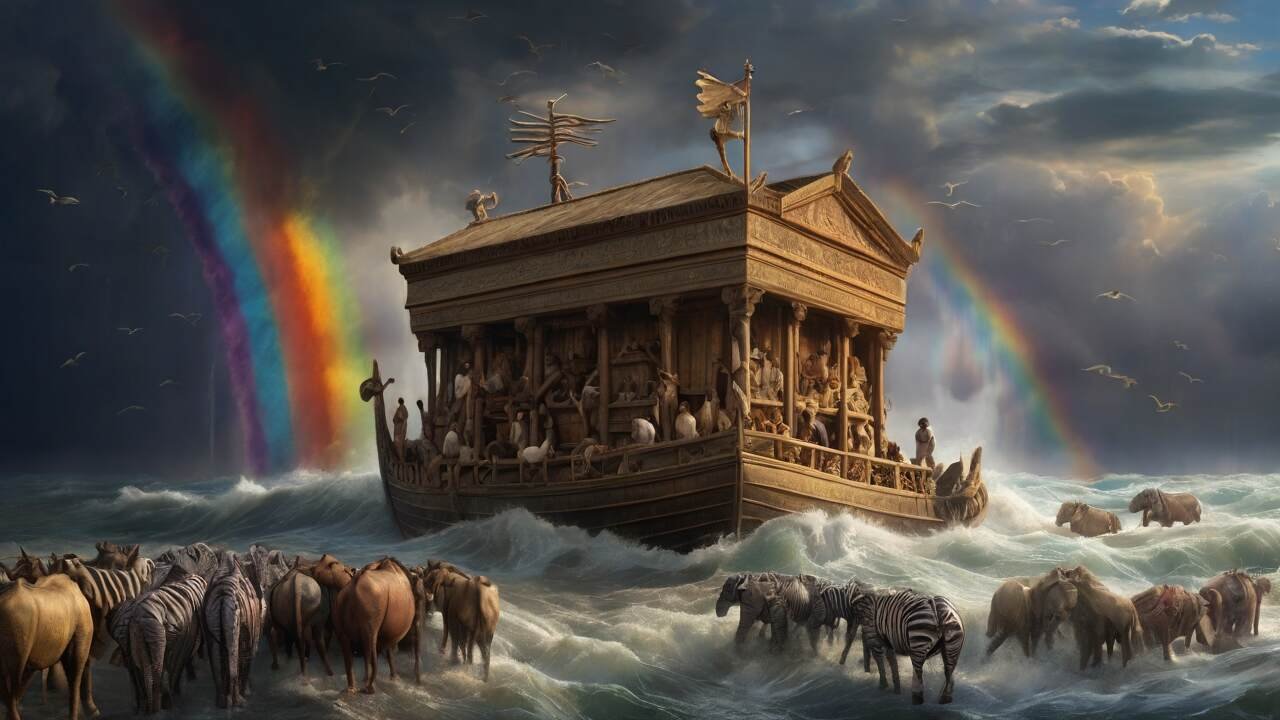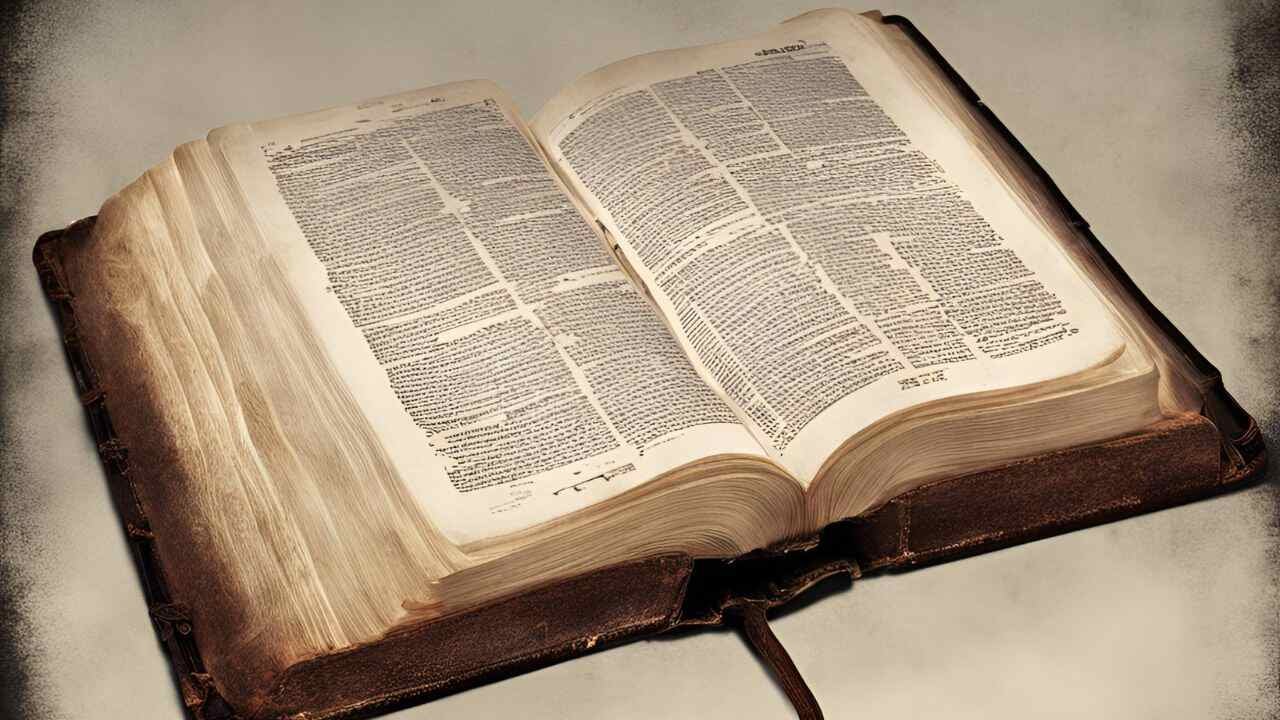In the King James Bible, the creation story is laid out in the Book of Genesis. This account starts with God creating the heaven and the earth. The earth was initially without form and darkness covered the deep waters. God’s Spirit moved over the waters, and God commanded, “Let there be light,” resulting in light separating from darkness.
As the days progressed, God transformed this cosmos. An expanse is created to separate waters, forming the sky. Dry land, seas, and vegetation are established next. God then puts celestial bodies in place to mark time—sun to rule the day and moon and stars to dominate the night. Nature’s diverse life forms soon follow, filling waters and skies with creatures.
Finally, God creates land animals and mankind. Humans are made in God’s image, tasked with dominion over Earth’s creatures. The process ends with a day of rest, marking the completion of creation. To explore further details of this fascinating narrative, you can check out more on The Creation Story.
Key Takeaways
- God created heaven and earth, highlighting faith’s foundational story.
- Celestial bodies and life forms emerged in an organized sequence.
- Humans were given dominion and responsibility over the earth.
The Initial Act of Creation
In the King James Bible, the creation story begins with God creating Heaven and Earth. The initial state of the world is described as formless and empty. This section breaks down these initial acts of creation into key elements.
The Formless Earth and the Spirit of God
At the very start, Heaven and Earth are created. The Earth is described as formless and empty. Darkness is over the surface of the deep waters. The important figure here is the Spirit of God, which moves over the waters. This spirit signifies God’s presence and power, setting the stage for the coming acts of creation.
Key points:
- Earth is initially without form and void.
- Darkness covers the deep waters.
- The Spirit of God moves over the waters, showing divine presence and control.
The First Day: Light and Darkness
On the first day, God commands, “Let there be light.” This command brings light into existence. God sees that the light is good and separates it from darkness. Light is called Day and darkness is called Night. This separation marks the first division of time, establishing the cycle of day and night.
Key points:
- God’s command brings light into being.
- Light is seen as good and is separated from darkness.
- Light is called Day and darkness is called Night, creating the first day-night cycle.
For further details, you can refer to the King James Bible Creation Story and Genesis 1 GNT;NIV.
Separation and The Sky
In the King James Bible, the creation story describes how God separated the waters to form the sky. This act of separation is detailed and organized, highlighting the creation of the firmament.
The Second Day: The Firmament
On the second day, God created the firmament. The firmament is a vast expanse that separated the waters above from the waters below. It is also referred to as the sky or vault.
God said, “Let there be a firmament in the midst of the waters, and let it divide the waters from the waters.” This act of separation was crucial in forming the structure of the world.
Under this firmament, the waters below gathered, allowing dry land to appear later. The waters above were retained in the sky. This separation established distinct realms, making the earth habitable.
The creation of the firmament showcases God’s power in organizing the universe. You see the sky as a clear division between different parts of existence, essential for the environmental balance described in the Bible.
Land, Seas, and Vegetation
In the King James Bible, the creation story describes how God formed the land, seas, and vegetation on the third day of creation. This stage involves the appearance of dry ground and the growth of various plants.
The Third Day: Dry Land and Plants
On the third day, God said, “Let the waters under the heaven be gathered together unto one place, and let the dry land appear.” The gathered waters were called Seas, and the dry land was named Earth. God saw that it was good.
Next, God spoke again, commanding the Earth to bring forth vegetation. The land responded by producing grass, herbs yielding seeds, and fruit trees bearing fruit with seeds. Each plant grew according to its kind. The variety and orderliness highlight the meticulous nature of creation. The emergence of these plants provided a foundation for sustaining future life on Earth.
Celestial Bodies and Time
The creation story in the Bible not only speaks of the earth and its inhabitants but also details the creation of celestial bodies and their roles in marking time.
The Fourth Day: Sun, Moon, and Stars
On the fourth day of creation, God created the celestial bodies to serve several purposes.
God made two great lights—the greater light (the sun) to rule the day and the lesser light (the moon) to rule the night. The stars were also created to give light to the earth.
These lights were set in the sky to separate day and night, marking seasons, days, and years. The evening and morning were part of this cycle, demonstrating how these celestial bodies help regulate time.
For more details on their significance, you can read about the celestial and terrestrial bodies here.
Life in Water and Air
The King James Bible describes the creation of life in water and air on the fifth day. God populated the waters with various kinds of fish and other sea creatures, and the sky with birds.
The Fifth Day: Fish and Birds
On the fifth day, God said, “Let the waters bring forth abundantly the moving creature that hath life.” He created great whales, fish, and other creatures of the sea. These living creatures filled the waters, showcasing a diverse and vibrant underwater world.
Birds were also created on this day. God commanded, “Let the fowl fly above the earth in the open firmament of heaven.” As a result, the sky was filled with flying birds, each designed to thrive in the air. The presence of birds and sea creatures marked an essential step in God’s plan, making the world more complete and lively. For a detailed account of these events, you can refer to the creation story in the King James Bible.
Land Animals, Mankind, and Rest
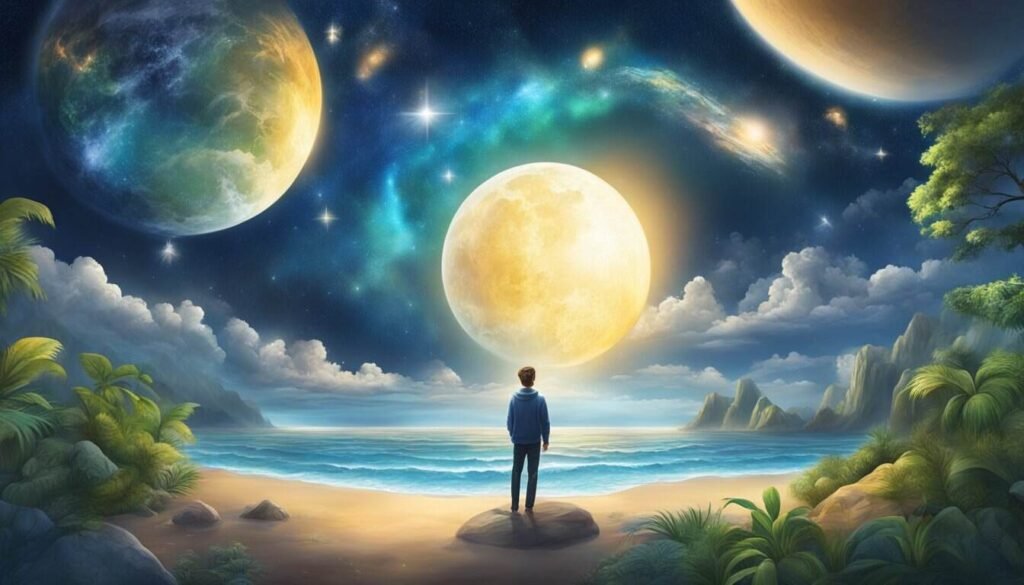
The sixth day focused on the creation of land animals and humans, while the seventh day emphasized rest and sanctification.
The Sixth Day: Animals and Man
On the sixth day, God created a variety of living creatures. These included beasts of the earth, livestock, and wild animals. Each was made according to its kind. This meant that various species were created with the ability to reproduce their own.
After creating animals, God turned to the creation of mankind. Man and woman were made in the image of God and likeness. This distinguished humans from other creatures. God referred to them as male and female, naming them Adam and Eve.
Humans were given dominion to rule over all creatures. This included the fish of the sea, the birds of the air, and every living thing on the land. God’s creation of mankind was described as “very good”.
The Seventh Day: Divine Rest and Sanctification
On the seventh day, God completed His work and chose to rest. This was not due to weariness but to set a sacred time for rest and reflection.
This day became known as the Sabbath, a day of rest and holiness. God blessed the seventh day, making it a sacred time for rest and sanctification.
The concept of the Sabbath is an essential principle. It emphasizes a rhythm of work and rest, inviting you to pause and reflect on creation, mirroring God’s divine rest.
Frequently Asked Questions
The biblical creation story, as told in the King James Version, offers a detailed account of how God created the world in seven days, explaining the significance of each act and the theological themes behind them.
What are the seven days of creation according to Genesis chapters 1 and 2?
Day 1: God created light, separating it from darkness, calling light “day” and darkness “night.”
Day 2: God created an expanse to separate waters, calling it “sky.”
Day 3: God gathered the waters to form seas and dry ground, calling the dry ground “land.”
Day 4: God created the sun, moon, and stars to separate day and night.
Day 5: God created sea creatures and birds.
Day 6: God created animals and mankind, making man in His image.
Day 7: God rested, blessing the day and making it holy.
What does Genesis chapter 1 verse 1 signify in the context of the biblical creation narrative?
Genesis 1:1 states, “In the beginning God created the heaven and the earth.” This verse introduces the entire creation story, emphasizing that God is the ultimate Creator. It sets the stage for the detailed process of creation that follows, highlighting God’s power and sovereignty.
How is the story of Adam and Eve’s creation and fall detailed in Genesis chapter 3?
Genesis 3 describes the creation of Adam and Eve in the Garden of Eden. They lived in innocence until the serpent tempted Eve to eat from the forbidden tree. She then gave the fruit to Adam. Their disobedience led to the fall, introducing sin and suffering into the world. God then expelled them from Eden.
Can you summarize the sequence of events in the biblical account of creation?
The creation story begins with God creating light and separating it from darkness. It continues with the formation of the sky, land, seas, and then the creation of plants, animals, and humans. Each day involves a specific creative act, culminating with God’s rest on the seventh day, blessing and sanctifying it.
What theological themes are presented in the creation story found in the King James Version of the Bible?
Key themes include God’s omnipotence, the intentionality of creation, human beings made in God’s image, and the sanctity of rest. These themes underscore God’s authority, creativity, and the relationship between humanity and the Creator. The narrative also introduces the concept of order from chaos and the inherent goodness of creation.
In what year was the King James Version of the Bible first published, and how does it narrate the creation story?
The King James Version was first published in 1611. It narrates the creation story in a majestic and poetic style that has resonated with readers for centuries. The language is formal and dignified, capturing the grandeur of God’s creative acts and the foundational beliefs of the Christian faith.
